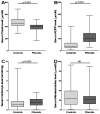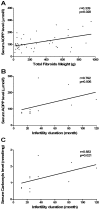Increased serum oxidative stress markers in women with uterine leiomyoma
- PMID: 23951284
- PMCID: PMC3739822
- DOI: 10.1371/journal.pone.0072069
Increased serum oxidative stress markers in women with uterine leiomyoma
Abstract
Background: Uterine leiomyomas (fibroids) are the most common gynaecological benign tumors in premenopausal women. Evidences support the role of oxidative stress in the development of uterine leiomyoma. We have analysed oxidative stress markers (thiols, advanced oxidized protein products (AOPP), protein carbonyls and nitrates/nitrites) in preoperative sera from women with histologically proven uterine leiomyoma.
Methodology/principal findings: We conducted a laboratory study in a tertiary-care university hospital. Fifty-nine women with histologically proven uterine leiomyoma and ninety-two leiomyoma-free control women have been enrolled in this study. Complete surgical exploration of the abdominopelvic cavity was performed in each patient. Preoperative serum samples were obtained from all study participants to assay serum thiols, AOPP, protein carbonyls and nitrates/nitrites. Concentrations of serum protein carbonyl groups and AOPP were higher in leiomyoma patients than in the control group (p=0.005 and p<0.001, respectively). By contrast, serum thiol levels were lower in leiomyoma patients (p<0.001). We found positive correlations between serum AOPP concentrations and total fibroids weight (r=0.339; p=0.028), serum AOPP and serum protein carbonyls with duration of infertility (r=0.762; p=0.006 and r=0.683; p=0.021, respectively).
Conclusions/significance: This study, for the first time, reveals a significant increase of protein oxidative stress status and reduced antioxidant capacity in sera from women with uterine leiomyoma.
Conflict of interest statement
Figures


Similar articles
-
Protein oxidative stress markers in peritoneal fluids of women with deep infiltrating endometriosis are increased.Hum Reprod. 2015 Jan;30(1):49-60. doi: 10.1093/humrep/deu290. Epub 2014 Nov 5. Hum Reprod. 2015. PMID: 25376454
-
Oxidative stress markers are increased since early stages of infection in syphilitic patients.Arch Dermatol Res. 2012 Nov;304(9):689-97. doi: 10.1007/s00403-012-1271-z. Epub 2012 Aug 4. Arch Dermatol Res. 2012. PMID: 23011658
-
Profibrotic interleukin-33 is correlated with uterine leiomyoma tumour burden.Hum Reprod. 2013 Aug;28(8):2126-33. doi: 10.1093/humrep/det238. Epub 2013 Jun 5. Hum Reprod. 2013. PMID: 23739220
-
A subserosal, pedunculated, multilocular uterine leiomyoma with ovarian tumor-like morphology and histological architecture of adenomatoid tumors: a case report and review of the literature.J Med Case Rep. 2016 Dec 20;10(1):352. doi: 10.1186/s13256-016-1167-1. J Med Case Rep. 2016. PMID: 27998309 Free PMC article. Review.
-
Hypercalcemia associated with a uterine leiomyoma: a case report and review of the literature.Gynecol Oncol. 2004 Apr;93(1):269-71. doi: 10.1016/j.ygyno.2004.01.013. Gynecol Oncol. 2004. PMID: 15047251 Review.
Cited by
-
Advanced oxidation protein products change biological behaviors of rat endometrial epithelial cells by activating ERK/P38 signaling pathways.Biol Open. 2020 Jun 1;9(5):bio048876. doi: 10.1242/bio.048876. Biol Open. 2020. PMID: 32366372 Free PMC article.
-
XPG rs873601 G>A contributes to uterine leiomyoma susceptibility in a Southern Chinese population.Biosci Rep. 2018 Sep 13;38(5):BSR20181116. doi: 10.1042/BSR20181116. Print 2018 Oct 31. Biosci Rep. 2018. PMID: 30139812 Free PMC article.
-
Advanced oxidation protein products from the follicular microenvironment and their role in infertile women with endometriosis.Exp Ther Med. 2018 Jan;15(1):479-486. doi: 10.3892/etm.2017.5390. Epub 2017 Oct 30. Exp Ther Med. 2018. PMID: 29387200 Free PMC article.
-
Correlation of oxidant status with oxidative tissue damage in patients with rheumatoid arthritis.Clin Rheumatol. 2014 Nov;33(11):1557-64. doi: 10.1007/s10067-014-2597-z. Epub 2014 Apr 10. Clin Rheumatol. 2014. PMID: 24718487
-
Expression profiles of E/P receptors and fibrosis in GnRHa-treated and -untreated women with different uterine leiomyomas.PLoS One. 2020 Nov 13;15(11):e0242246. doi: 10.1371/journal.pone.0242246. eCollection 2020. PLoS One. 2020. PMID: 33186388 Free PMC article. Clinical Trial.
References
-
- Baird DD, Dunson DB, Hill MC, Cousins D, Schectman JM (2003) High cumulative incidence of uterine leiomyoma in black and white women: ultrasound evidence. Am J Obstet Gynecol 188: 100-107. doi:10.1067/mob.2003.99. PubMed: 12548202. - DOI - PubMed
-
- Dubuisson JB, Fauconnier A, Fourchotte V, Babaki-Fard K, Coste J et al. (2001) Laparoscopic myomectomy: predicting the risk of conversion to an open procedure. Hum Reprod 16: 1726-1731. doi:10.1093/humrep/16.8.1726. PubMed: 11473973. - DOI - PubMed
-
- Wilcox LS, Koonin LM, Pokras R, Strauss LT, Xia Z et al. (1994) Hysterectomy in the United States, 1988-1990. Obstet Gynecol 83: 549-555. doi:10.1097/00006250-199404000-00011. PubMed: 8134065. - DOI - PubMed
-
- Lafay Pillet MC, Leonard F, Chopin N, Malaret JM, Borghese B et al. (2009) Incidence and risk factors of bladder injuries during laparoscopic hysterectomy indicated for benign uterine pathologies: a 14.5 years experience in a continuous series of 1501 procedures. Hum Reprod 24: 842-849. PubMed: 19122211. - PubMed
MeSH terms
Substances
LinkOut - more resources
Full Text Sources
Other Literature Sources
Medical

